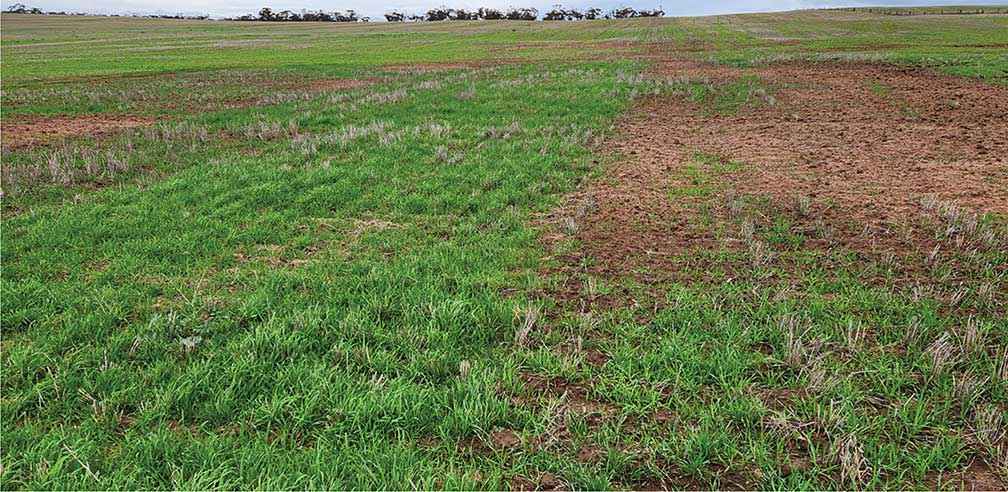Victorian Landcare Magazine - , Issue 89

Salinity is a major challenge for farmers in Victoria’s low-rainfall regions, impacting productivity and threatening long-term soil health. Mallee Sustainable Farming (MSF) has developed two innovative tools that are helping growers manage and remediate saline-affected landscapes at scale. The Dry Saline Land Decision Tree and the Mallee Seeps Decision Tree are now available to support farmers to bring degraded land back into production.
The Dry Saline Land Decision Tree was developed to provide farmers with a practical, step-by-step guide to addressing dry saline land, also known as magnesia country – a growing problem across southern Australia, particularly during extended periods of drought. This interactive tool helps farmers identify the signs of dry saline land, understand the causes, and implement strategies that have been field-tested by farmers across South Australia, Victoria, and western New South Wales.
The Mallee Seeps Decision Tree focuses on salinity caused by Mallee seeps which occur where perched groundwater reaches the surface, typically in low lying farmland. This water is underutilised below the ground. When it moves into a recharge zone where excess water sits on the surface it causes soils to become waterlogged and eventually salinised through evaporation.
The Mallee Seeps Decision Tree guides farmers through identifying the problem, understanding the difference between Mallee seeps and other forms of salinity, and choosing the most effective management strategies. Together, these tools provide a comprehensive framework for farmers facing diverse salinity challenges.
With drought conditions intensifying, dry saline land can become more severe. In low-rainfall years, the lack of leaching rains leads to increased salt accumulation at the soil surface, causing saline patches to expand. Without proper intervention, these areas can grow larger impacting productive land.
With drought conditions intensifying, dry saline land can become more severe.
The Dry Saline Land Decision Tree provides practical solutions to reduce evaporation, manage bare patches, and encourage soil cover. Farmers can use the decision tree to explore different management options. Establishing and maintaining soil cover with straw, mulches and ameliorating with sand can reduce evaporation and break the capillary rise of salts to the surface.
Opportunistic management of seasonal rainfall and taking immediate action when good rainfall returns can be valuable, along with using salt-tolerant varieties that are most likely to thrive in saline soil conditions.
These strategies have been tested to address the unique challenges of farming in low-rainfall areas, offering farmers the flexibility to adapt their management based on local conditions.
MSF’s approach has shown promising results in bringing degraded land back into production. Since 2018, and with support from the Australian Government’s National Landcare Program for Mallee seeps and Future Drought Fund for dry saline land, MSF has worked closely with farmers to implement a range of management strategies at demonstration sites across the Eyre Peninsula, SA’s Upper North and tri-state Mallee region. These efforts have highlighted the importance of combining innovative techniques with local knowledge to achieve the best results.
For example, the Mallee Seeps Decision Tree has helped farmers manage areas affected by perched water tables. A farmer in Victoria’s Mallee region used deep-rooted perennials to lower the water table and reduce the risk of seeps forming. These plants helped draw excess water from the soil, stabilising the spread of seeps and preventing new saline patches from emerging. Over time, the affected paddocks saw a return to productivity, demonstrating the long-term benefits of targeted management.
One of the key successes featured in the Dry Saline Land Decision Tree involves using sand as a mulch. In several Mallee trial sites, farmers found that spreading a layer of sand over bare saline patches significantly improved soil conditions. The sand acts as a barrier, reducing evaporation and disrupting the capillary rise of salts. This technique allowed farmers to re-establish ground cover and improve crop establishment in areas previously too salty for growth.

Above: Using sand as a mulch to improve germinating conditions and encourage establishment of ground cover in the Mallee in 2023.
Another practical strategy that has proven successful is leveraging opportunistic rainfall. When a decent rainfall occurs, it can flush salts deeper into the soil profile, creating a narrow window for effective action. Some farmers have taken advantage of this by sowing salt-tolerant crops immediately after a good rain, allowing them to establish cover quickly before conditions deteriorate again.
The decision trees are a comprehensive resource hub for farmers seeking to improve soil health and resilience in the face of salinity challenges. Each decision tree is interactive, featuring links to case studies, videos, and downloadable guides that make it easy for farmers to access information tailored to their needs.
Tanja Morgan is Program Manager – Outreach with MSF. For more information and to use the decision trees go to www.msfp.org.au/projects/fixing-saline-soils/